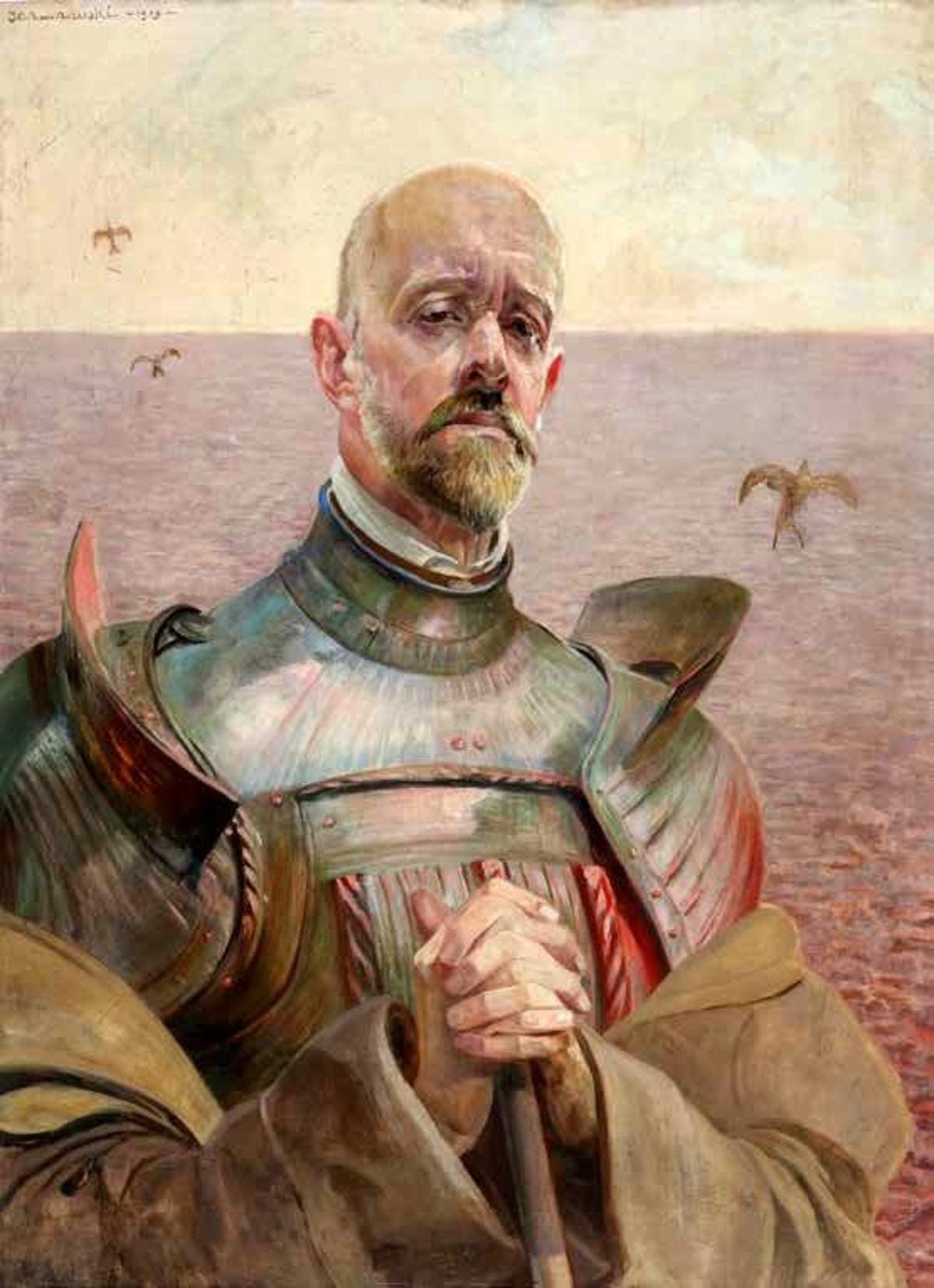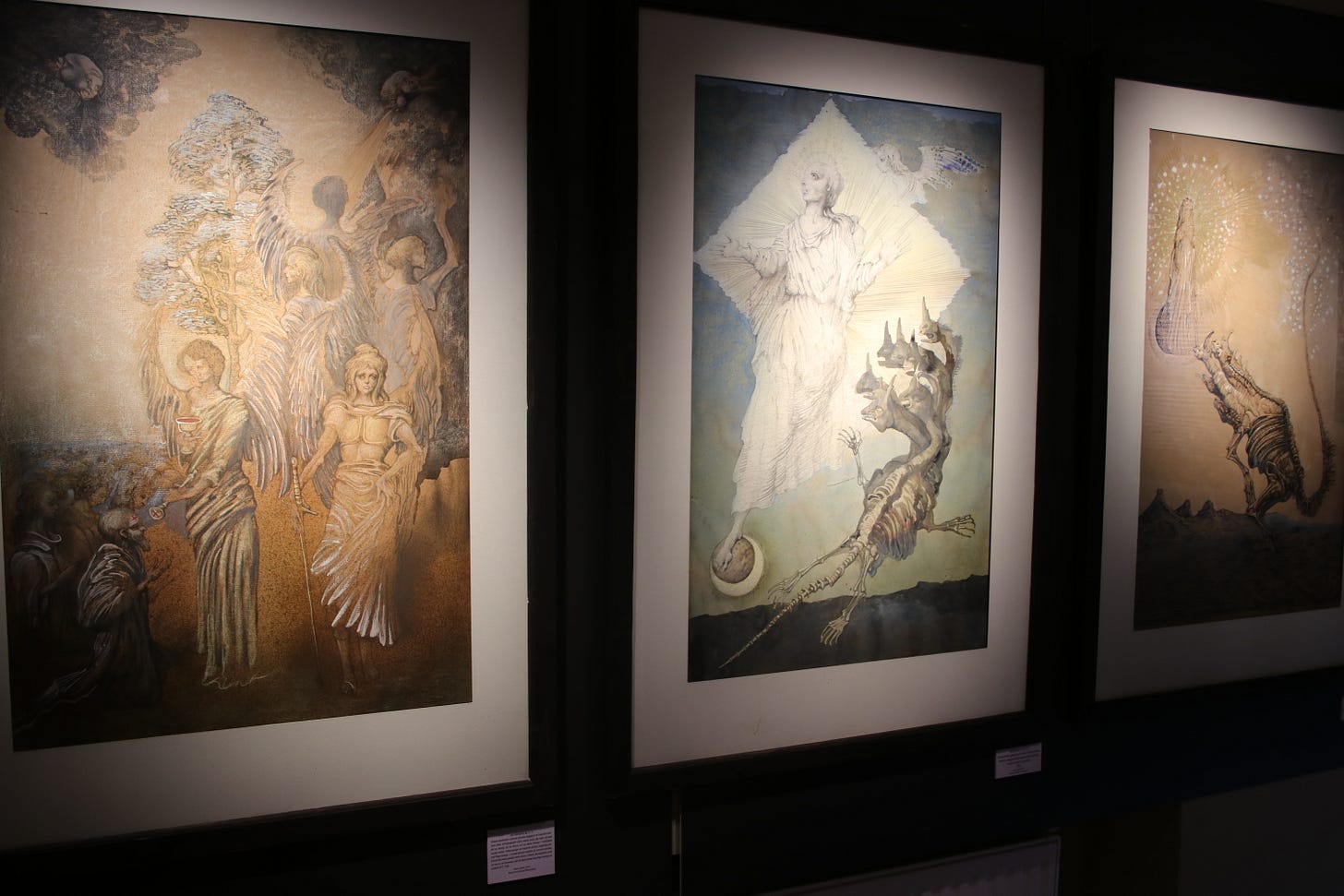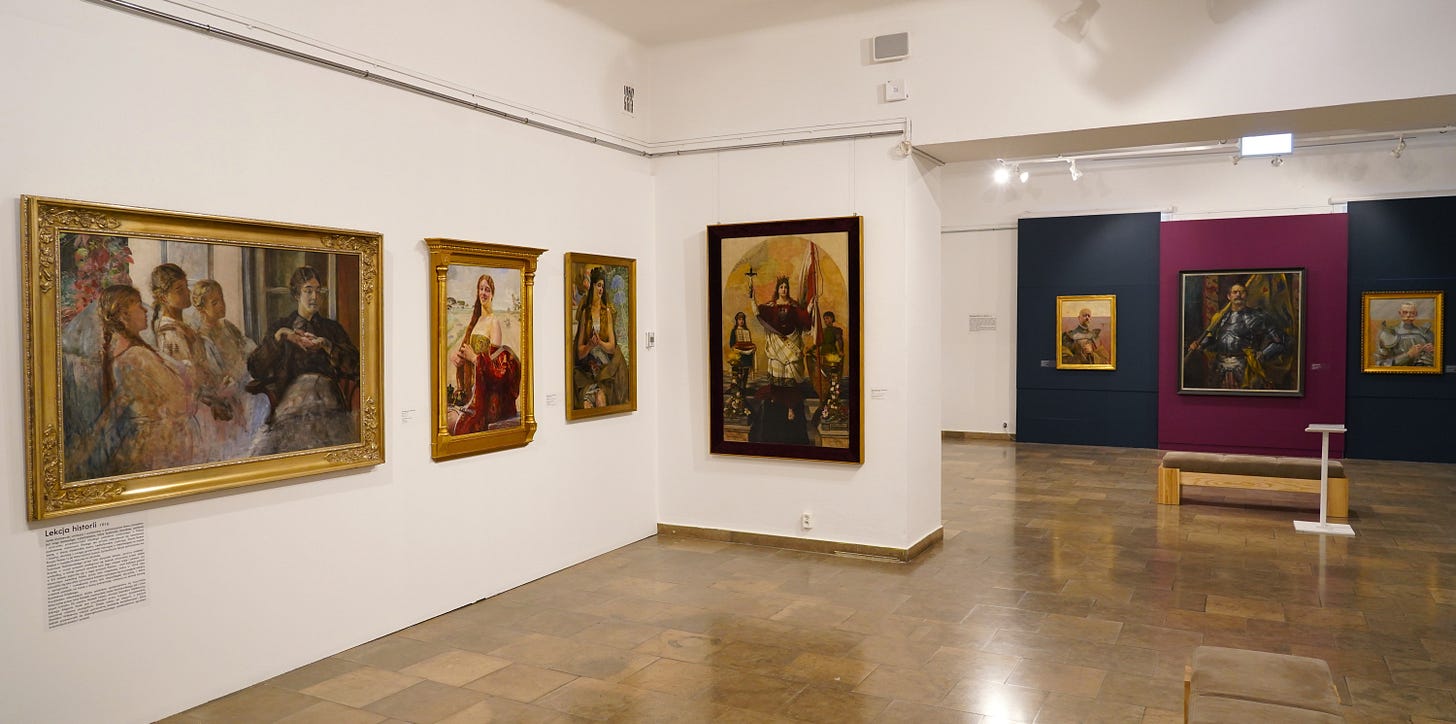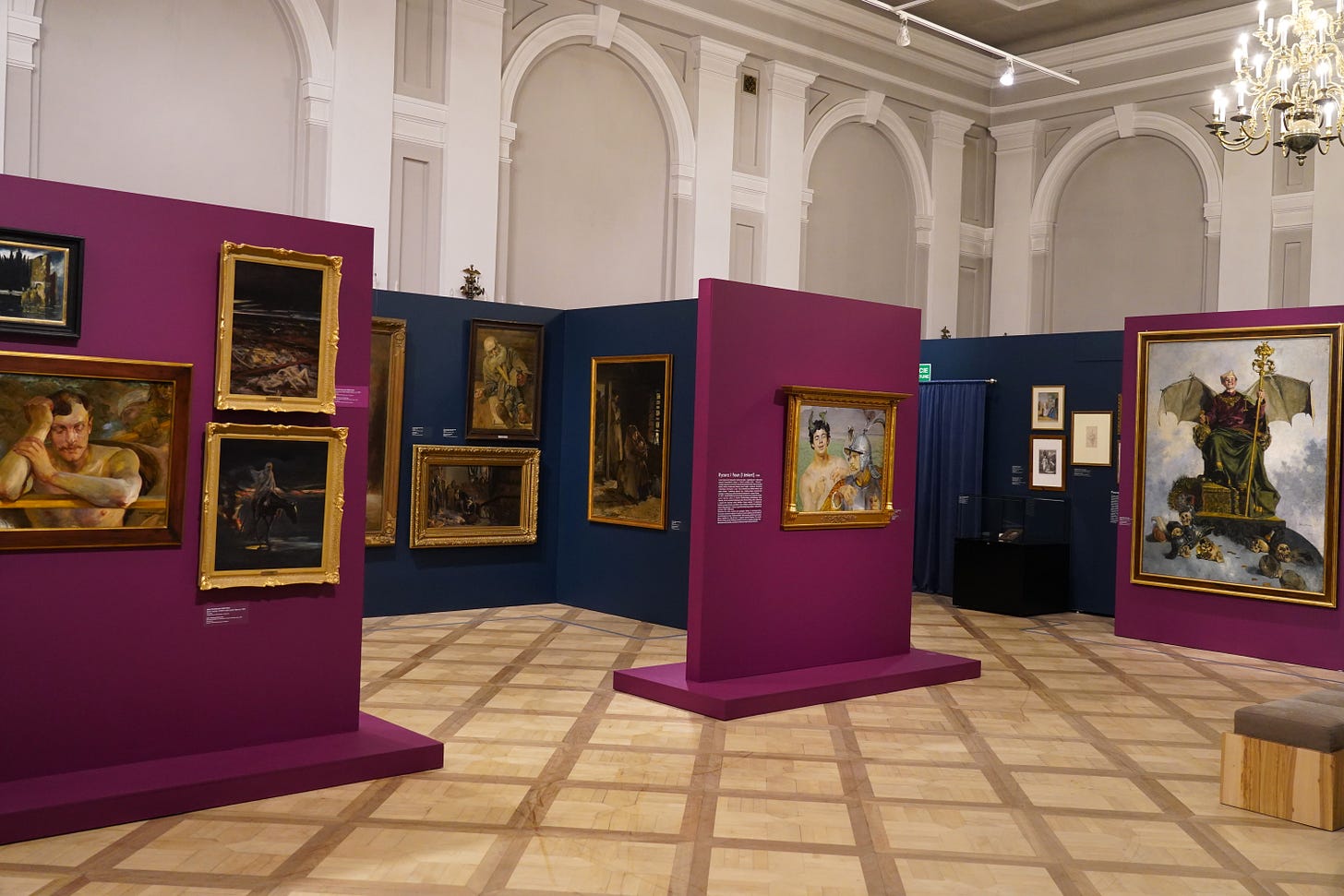Martyrs and Mythmakers
Two Polish heroes and mythologisers caused me to reflect on the potential of national myths for creators today.

I.
Prawda i Wolność. Ksiądz Jerzy Popiełuszko (Truth and Freedom. Father Jerzy Popiełuszko) (7 June-3 November 2024) held at the Museum of the Archdiocese of Warsaw is about Father Jerzy Popiełuszko (1947-1984), timed to mark the 40th anniversary of his death. Popiełuszko studied at a seminary and did his national service in a regiment composed of seminarians. They were treated harshly by their Communist officers, who tried to break their faith by forcing them to perform arduous tasks and punishing them for slight infractions. Popiełuszko was ordained as a priest after he completed his obligations, being assigned to St. Stanilaus Kostka Church, which is now the site of his grave and a museum on the life of Popiełuszko. The display is informative and affecting, although as signage in English is very limited, it is best for you to read up before your arrival.
Popiełuszko became sympathetic to the popular resistance to Communist rule that began in the 1970s and which led to industrial action, strikes and riots. The foundation of Solidarity, a party that had its roots in the industrial centres of Gdansk and Warsaw, created an organised counter-elite movement that had widespread support. Popiełuszko preached at the Warsaw steel mill. He was identified as a prominent figure in the anti-government movement and subject to surveillance, arrest and intimidation. On 30 October he was abducted, tortured and drowned by members of the Polish security police, who were later tried and found guilty of murder. Popiełuszko was beatified in 2010. Claims for miracles (the final requirement for sainthood) are currently being evaluated by the Vatican.
The temporary display is of photographs, documents and artefacts relating to the life of the priest. These are shown alongside art, some of which was made in response to the priest posthumously. Photographs of protests and open-air masses reflect the social events of that era. The art selected is very broad in terms of style and content. There are Neo-Expressionist pictures from around 1984 that we might expect to find in a collection of West German painting. Jacek Sroka is a fine painter with an acerbic outlook. His heads are troubling: part monster, part victim. Wiesław Szamborski’s large mixed-media painting-collage Welcome (1968) is a piece of Kitaj-style Pop Art. Andrzej Feliks Szumigaj’s Break (1978) is a giant portrait head of a worker which blends Polish-approved Socialist Realism with American Photorealism.
Later paintings are of the grave side of Popiełuszko and paintings treating him as a martyr, both to Christianity and the Polish people. Considering the history of Poland and the suffering of the Poles as a vassal state of the USSR, it is entirely understandable and fitting to see Popiełuszko in this way. There is a set of Apocalypse paintings by Jan Lebenstein dedicated to Popiełuszko, which function an indirect homage to all the Polish victims of Communism. Lebenstein was a refugee from Poland, living in Paris, who drew inspiration from Renaissance manuscripts to create his fantastic imagery paying tribute to the murdered priest. Many of the paintings are owned by the Museum of the Archdiocese of Warsaw, because during the 1980s artists exhibited art at Church museums as a way of evading (and boycotting) state-sanctioned venues. Many of these paintings were donated to the Church, consequently giving the Church a unique and rich resource of dissident art in its permanent collection.
II.
Jacek Malczewski (1854-1929) is the most important Polish Symbolist painter. His primary subject was the history and destiny of the Polish nation. Malczewski was born in an era when Poland was divided between Prussia, Russia and Austro-Hungary. He became part of the Young Poland movement, which provided new cultural material as of the campaign to win autonomy for a unified Poland. Only in 1918, with the cataclysm of the Great War – which saw Germany and Austro-Hungary defeated and Russia divided and weakened – did Poland gain its independence, unified for the first time since 1795.
To mark the 170th anniversary of his birth, Jacek Malczewski: Konteksty (Jacek Malczewski Museum, Radom, 20 September 2024-5 January 2025) has opened in Radom, town of the artist’s birth. The exhibition is an attempt to answer the question posed in the catalogue introduction. “What could inspire Jacek Malczewski’s painting and how far was his creativity a distinctive and original phenomenon in the epoch he lived in?” Curatorial selections of art from Poland and other European countries are judicious; many of the loans are from private collections.
The Malczewski family was a part of the intellectual patriotic gentry of somewhat reduced means, located in Radom. The family was Catholic, was a strong mystical Franciscan view of their faith. The belief that death – however profound and awful – was not the end was something that inform Malczewski’s spiritual understanding and direct his art.
When Malczewski began his studies Jan Matejko (1838-1893) was the leading exponent of Polish History painting. He studied first in Krakow under Matejko (1872-6) and then in Paris. Early pieces show Malczewski copying reproductions and closely following the currents of Romantic, Post-Romantic and Symbolist art and literature, as well as working in the genres of religious and History painting. As a pure History painter, Malczewski acquitted himself well. The affect of seeing firsthand the results of the doomed Polish uprising of January 1863 (fighting during which was particularly fierce around Radom) left a deep impression on the nine-year-old artist. As all Poles were, he had been raised to meditate upon the sacrifices of the equally bloody failed revolt of 1830-1. The most powerful scene in the exhibition is After the Harvest (1892) is of dead soldiers in a farmyard; the bedraggled bodies lie around a rotating gate, like autumn leaves blown to there; in the background a dog howls, muzzle turned to the sky.

In many pictures we see the Russian greatcoat. Polish patriots were deported by the Russians to Siberia; in Malczewski’s painting the Russian greatcoat worn by the prisoners repeatedly reappear as symbolic of the yoke of Russian hegemony. In many realist paintings from the 1880s Malczewski’s lone figures in greatcoats act as ciphers of nationalism denied by the interests of foreign powers – a coded condemnation of tyranny.
Eventually Malczewski would reject the path set out for by Matejko to be his successor and the leading Polish History painter of next generation. Symbolism, and its capacity to carry coded autobiography, seemed richer to Malczewski than the more laborious and less flexible approach of History painting, with its reliance on research, accuracy and meeting the expectations of museum directors.
In the exhibition we see the different component parts of Malczewski’s distinctive signature style individually and comingled. There are pastoral scenes, some painted near Krakow or outside Radom. The peasant scenes (a police line up, a burial, a village dance) establish Malczewski’s credentials as an observer of everyday life and provided him with a familiarity that will prove valuable for his later allegorical scenes. It is these for which he is best known. By the 1890s Malczewski had broken free of both Realism and History painting as genres and had forged a more individual path. His later inventions spring from an abiding fascination with the life of Polish people, imagined and memorised, into which is grafted elements of folklore. He often appears in his paintings; his beard and shaved head makes him a recognisable figure. He takes on the role of the seer, the pioneer, the avatar of a Polish nation apparently forever doomed to be stateless.
Malczewski acquired (some accounts say that he personally forged) a suit of armour, in which he and various subjects appeared, usually in a portrait bust accompanied by allegorical figures. In the allegories, exiles returning from Siberia are seen dying at the gate of the homestead, having walked over a thousand miles, their circle of life completed. In a 1913 canvas, Thanatos as an angel of death greets a man at the revolving gate that Malczewski (then living in Krakow) remembered from his childhood. The exact meaning of the allegories is obscured by the artist’s blending of Biblical, Greek and Polish stories, as well as the epic poem Anhelli by Juliusz Słowacki.
The exhibition includes a number of portraits of artists by Malczewski, generous and insightful.
A storming portrait of a figure with brushes places an orange mantle against a cerulean blue background; one could mistake it for a self-portrait, as the artist and subject look similar. It is actually Leon Wyczolkowski, an artist colleague and member of the Young Poland, painted c. 1895. The image is of a heroic figure, full of energy, made glorious by his dedication to the national cause. The combination of large size, bold brushwork and strong colour renders this a bravura performance. The colours in reproduction are more intense than shown here and reveal Malczewski as an adventurous colourist.

The portrait of Wacław Koniuszko (1854-1900) is a wonderful piece. The unbalanced figure, with the expression of confusion, tie askew is a perfect embodiment of the subject. Koniuszko was a fellow artist who suffered from syphilis. This portrait (made by Malczewski c. 1896-8) captures the painter’s unstable, damaged state, with the shocking orange-pink lighting (shadows of turquoise and cobalt blue) heightening the unearthly damned quality of the subject. Kudos to Malczewski for not pulling his punches but instead emphasising the horror of what he was witnessing. One wonders what Koniuszko made of it. He died shortly after this remarkable portrait was executed.
The exhibition includes a few of my favourite Malczewski’s paintings. The series My Life was painted over 1914-9. The artist recalled his summers in the family farm in Wielgie, near Radom. Scenes of the farm and local landscape are peopled by Malczewski as a boy and various Polish archetypes and the artist’s pantheon of myth. My Soul (1917) shows grieving and cradling the body of the artist lying beside on the pathway of the farm. It is a beautiful elegiac painting, composed by an artist reflecting on a life reaching its conclusion, and one concludes that My Life was a series designed to sum up the artist’s abiding concerns and condense memory and myth.
Why should you care about Malczewski? Overall, Malczewski is an exciting and inventive painter. The best of his pictures are startling, powerful and highly original. He was completely committed to the importance of art and the seriousness of his art, without foregoing the element of humour and peculiarity. His fusion of personal and allegorical, combined with a partiality for the patriotic and folkloric, makes him a powerful patriotic artist. In his own way, Malczewski is as important as Matejko, although for different reasons. While Matejko painted specific moments of Polish history in an iconic manner – distilling a story into a perfect formulation – Malczewski blended Polish landscape and stories into non-specific haunting tableaux. If one were to see paintings by each without knowing about them, it is Malczewski’s which would seem “more Polish” in style, imagery and colour than Matejko’s masterful pan-European manner.
III.
Although there is no direct link between the two exhibitions (both timed for anniversaries), one sees the power of patriotism and faith and of working for one’s people against authorities that serve outside interests, reflected through the lens of Polish history. Is such heroism – either overt or implicit – applicable to us today? Before we weigh this up, it has to be noted that every national story is different and Poland’s history is very different to that of Great Britain and the United States, the locations where most of my readers live. That said, can we draw some lessons from the stories of two remarkable Poles that apply to us?
Even in Communist times, the patriotic story of the nation (divided by monarchs and emperors only to be united through the will of the people) however romanticised in the telling, still had a hold in popular and official life. Patriotism was pressganged into the Communist narrative of Poles overcoming the Nazi beast before attaining the dictatorship of the proletariat as a part of a brotherhood of nations among the Warsaw Pact. Despite the distortions of historical Marxist inevitability, patriotism was seen as valuable by Communists, nationalists and liberals in the 1945-89 period.
In the West now, patriotism has been thoroughly discredited for so long by the left and liberals; so much so that even the right is embarrassed to appeal to national pride, preferring to offer repackaged liberalism of the free-market, private-property, free-speech variety. The very idea that a determined and brave individual would place himself at risk or become isolated in order to champion his compatriots seems “cringe” to the right, just as the left would mock it as a delusion forged by cynical elites to manipulate the peons.
We are modern people raised at a time when “British values” are a skinsuit worn by every globalist who loathes the native British population and states that the core values of Christianity, nationalism and kinship were always secularism, multiculturalism and xenophilia. As several generations raised under a much-rewritten malleable national myth – that of openness, toleration and national symbols that are all of foreign origin – how can any national artist cite a national cause without having to explain what British (or more correctly, English, Welsh, Scottish and Ulster) nationalism is?
Already a nationalist artist is at a disadvantage because he has to be on the defensive merely to explain to his own people what nationalism means to him – and (by extension) what it should mean to his audience. This is not a matter that one can simply “step over” because the common symbols have been appropriated, so even using those symbols requires a degree of qualification. That qualification gives the appearance of weakness and reactionaryism, which acknowledges the power of anti-nationalist progressives, yet it cannot be any other way because the very language and concepts of nationhood have been thorough distorted and this is something that is imprinted on the minds of even ardent traditionalists and nationalists of our time. This is something that I shall be reflecting upon further.
NB: Edited for corrections, 8 October 2024
Sources:
Roger Diederen, Albert Godetzky, Nerina Santorius (eds.), Silent Rebels: Polish Symbolism around 1900, Hirmer, 2022, Munich
Agnieszka Ławniczakowa, Malczewski: A Vision of Poland, Barbican Art Gallery, 1990, London
Paulina Szymalak-Bugajska, Agnieszka Lewandowska, Jacek Malczewski: Konteksty, 2024, Muzeum im. Jacka Malczewski, Radom, hardback, 364pp, fully illus., Polish/English, 110 PLN




Thanks for your very interesting and thoughtful essay. The problem comes down to blood and soil, I believe. Europeans could eventually rally around their identities and historic culture. They have artifacts dating back thousands of years that can be a very strong emotional source, for lack of a better word.
But even words like identity, emotional source and history – abstractions – don't really suggest to me what is needed. It has to be a belief in an eternal order that has been cultivated from organic history. Something sacred, and like Scruton said, humans have to move with the gods and heroes in a kind of initiation and imitation, especially when young. The sacred being something untouchable and mysterious, hence the importance of images, gestures and sounds in time. This, to me, is the only way men can overcome the sacred-victim, entitled parasite cultural that has captured the West.
Visual artists certainly shoud be part of that and your essay on these Polish artists is illuminating and a step in the right direction.
Such an interesting discussion of Malczewski’s work. Sadly I’ve never see any of his paintings in person - I think his work hangs predominantly in galleries in Poland and the Ukraine. However, a dear friend of mine, now passed away, did gift me a book from an exhibition of Malczewski’s work in Warsaw some years’ ago. I love his use of figures from Greek mythology as in ‘Medusa’ and ‘The Artist and the Chimera’. ‘Melancholia’, clearly a commentary on the struggles of the Polish people over centuries of uprisings and division, is such a powerful piece on nationalism.